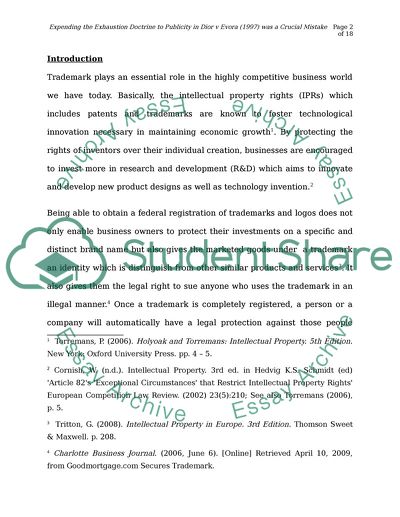Cite this document
(“Expending the exhaustion doctrine to publicity in Dior v Evora (1997) Essay”, n.d.)
Expending the exhaustion doctrine to publicity in Dior v Evora (1997) Essay. Retrieved from https://studentshare.org/miscellaneous/1553512-expending-the-exhaustion-doctrine-to-publicity-in-dior-v-evora-1997-ecr-i-6013-was-a-crucial-mistake-as-it-inevitably-damages-the-essential-function-of-the-trade-mark-discuss
Expending the exhaustion doctrine to publicity in Dior v Evora (1997) Essay. Retrieved from https://studentshare.org/miscellaneous/1553512-expending-the-exhaustion-doctrine-to-publicity-in-dior-v-evora-1997-ecr-i-6013-was-a-crucial-mistake-as-it-inevitably-damages-the-essential-function-of-the-trade-mark-discuss
(Expending the Exhaustion Doctrine to Publicity in Dior V Evora (1997) Essay)
Expending the Exhaustion Doctrine to Publicity in Dior V Evora (1997) Essay. https://studentshare.org/miscellaneous/1553512-expending-the-exhaustion-doctrine-to-publicity-in-dior-v-evora-1997-ecr-i-6013-was-a-crucial-mistake-as-it-inevitably-damages-the-essential-function-of-the-trade-mark-discuss.
Expending the Exhaustion Doctrine to Publicity in Dior V Evora (1997) Essay. https://studentshare.org/miscellaneous/1553512-expending-the-exhaustion-doctrine-to-publicity-in-dior-v-evora-1997-ecr-i-6013-was-a-crucial-mistake-as-it-inevitably-damages-the-essential-function-of-the-trade-mark-discuss.
“Expending the Exhaustion Doctrine to Publicity in Dior V Evora (1997) Essay”, n.d. https://studentshare.org/miscellaneous/1553512-expending-the-exhaustion-doctrine-to-publicity-in-dior-v-evora-1997-ecr-i-6013-was-a-crucial-mistake-as-it-inevitably-damages-the-essential-function-of-the-trade-mark-discuss.


